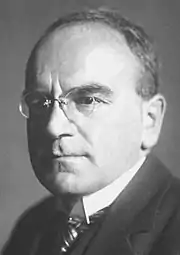Heinrich Otto Wieland
Heinrich Otto Wieland (German pronunciation: [ˈhaɪnʁɪç ˈviːlant] ⓘ; 4 June 1877 – 5 August 1957) was a German chemist. He won the 1927 Nobel Prize in Chemistry for his research into the bile acids.[1][2]
Heinrich Otto Wieland | |
|---|---|
 Heinrich Otto Wieland | |
| Born | 4 June 1877 |
| Died | 5 August 1957 (aged 80) |
| Nationality | German |
| Alma mater | University of Munich |
| Known for | Adamsite Bile acids research Barbier–Wieland degradation Wieland-Gumlich aldehyde Wieland rearrangement Wieland test |
| Awards | Otto Hahn Prize for Chemistry and Physics (1955) Pour le Mérite for Sciences and Arts (1952) Goethe Medal (1942) ForMemRS (1931)[1] Nobel Prize for Chemistry (1927) |
| Scientific career | |
| Fields | Chemistry |
| Institutions | Technical University of Munich 1913–1921, University of Freiburg 1921–25, University of Munich 1925– |
| Doctoral advisor | Johannes Thiele |
| Doctoral students | Rolf Huisgen, Leopold Horner |
Career
In 1901 Wieland received his doctorate at the University of Munich while studying under Johannes Thiele.[2][3] In 1904 he completed his habilitation, then continued to teach at the university and starting in 1907 was a consultant for Boehringer Ingelheim. In 1914 he became associate professor for special topics in organic chemistry, and director of the Organic Division of the State Laboratory in Munich. From 1917 to 1918 Wieland worked in the service of the (KWI) Kaiser Wilhelm Institute for Physical Chemistry and Electrochemistry in Dahlem then led by Fritz Haber[4] as an alternative to regular military service. There he was involved in weapons research for instance finding new synthetic routes for mustard gas. He is also credited with the first synthesis of Adamsite.
From 1913 to 1921, he was Professor at the Technical University of Munich. He then moved to the University of Freiburg as successor of Ludwig Gattermann (he also assumed responsibility for Gattermanns famous cookbook).[5] In Freiburg he started working on toad poisons and bile acids. In association with Boehringer Ingelheim he worked on synthetic alkaloids such as morphine and strychnine.
In 1925 Wieland succeeded Richard Willstätter as Chemistry Professor at the University of Munich.[6][5]
In 1941, Wieland isolated the toxin alpha-amanitin, the principal active agent of one of the world's most poisonous mushrooms Amanita phalloides.[5]
Wieland tried successfully to protect people, especially Jewish students, who were "racially burdened" after the Nuremberg Laws. Students who were expelled because they were "racially burdened" could stay in Heinrich Wieland's group as chemists or as "Gäste des Geheimrats" (guests of the privy councillor). Hans Conrad Leipelt, a student of Wieland, was sentenced to death after collecting money for Kurt Huber's widow Clara Huber.
Family
Heinrich's father, Theodor Wieland (1846–1928) was a pharmacist with a doctorate in chemistry. He owned a gold and silver refinery in Pforzheim.[4] Heinrich Wieland was a cousin of Helene Boehringer, the wife of Albert Boehringer, who was the founder of the Boehringer Ingelheim pharmaceutical company. He worked for the company from 1915-1920 and established the company's scientific department.
Eva Wieland, Heinrich Wieland's daughter, was married to Feodor Lynen on 14 May 1937.
Heinrich Wieland Prize
Since 1964, the Heinrich Wieland Prize has been awarded annually. First to promote research on chemistry, biochemistry, physiology and clinical medicine of lipids and related substances, nowadays the prize is awarded for outstanding research on biologically active molecules and systems in the fields of chemistry, biochemistry, and physiology as well as on their clinical importance. The prize is among the most treasured international science awards and has a successful history of over 50 years. The Heinrich Wieland Prize has been sponsored by Boehringer Ingelheim from 2000 to 2010. From 2011, it has been awarded by the Boehringer Ingelheim Foundation. The awardees have always been selected by an independent Board of Trustees. Since 2014, it has been endowed with 100,000 euros.[7]
References
- Karrer, P. (1958). "Heinrich Wieland 1877-1957". Biographical Memoirs of Fellows of the Royal Society. 4: 341–352. doi:10.1098/rsbm.1958.0026. S2CID 72627789.
- Bernhard Witkop (1993). "Remembering Heinrich Wieland (1877-1957) portrait of an organic chemist and founder of modern biochemistry". Medicinal Research Reviews. 12 (3): 195–274. doi:10.1002/med.2610120303. PMID 1578969. S2CID 32468158.
- Heinrich Otto Wieland on Nobelprize.org including the Nobel Lecture, December 12, 1928 The Chemistry of the Bile Acids
- Vaupel, Elisabeth (2007-12-10). "Interconnections and Independence: Heinrich Wieland (1877–1957) and His Era". Angewandte Chemie International Edition. 46 (48): 9154–9179. doi:10.1002/anie.200702255. PMID 18061927.
- Haslewood, G. A. (1957). "Prof. H. O. Wieland". Nature. 180 (4584): 462–463. Bibcode:1957Natur.180..462H. doi:10.1038/180462a0. PMID 13464859.
- "Heinrich Wieland - Biography".
- "Heinrich Wieland Prize". Boehringer Ingelheim Stiftung. Retrieved 2 June 2017.
External links
- Cox, David (3 July 2015). "Science of resistance: Heinrich Wieland, the biochemist who defied the Nazis". The Guardian.
- Heinrich Otto Wieland on Nobelprize.org including the Nobel Lecture, December 12, 1928 The Chemistry of the Bile Acids
- "Heinrich Wieland Prize – Homepage". heinrich-wieland-prize.de. Retrieved 2016-11-27.
